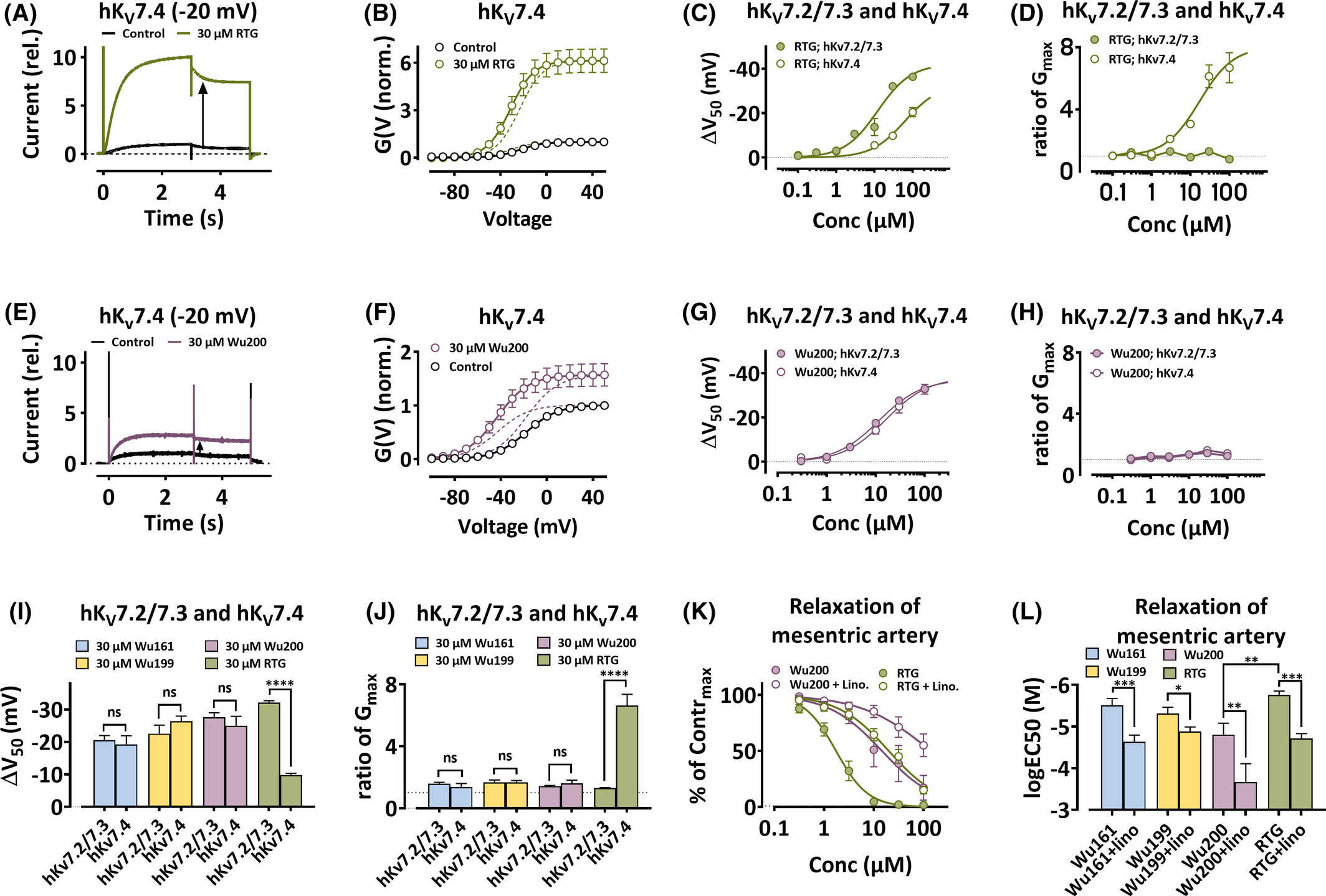Fig. 4 Retigabine (RTG) and resin acid derivatives open the KV7.4 channel and induce linopirdine-sensitive relaxation. A, Currents through hKV7.4 (expressed in Xenopus oocytes) in control and RTG as indicated. Holding voltage = −100 mV; voltage step 1 (3 s) = −20 mV; voltage step 2 (2 s) = −30 mV (tail currents). The instantaneous current at step 2 was increased by a factor of 10 (black arrow). B, G(V) curves for recordings as in A. Data = mean ± SEM. Equation 2: V50 = −21.1 ± 1.0 mV, −30.9 ± 1.2 mV, ΔV50 = −9.8 ± 0.5 mV; GMAX increased by a factor of 6.1 ± 0.2 (n = 7). Dashed line indicates the contribution from the GMAX increase and from the shift of G(V) respectively. C, Concentration-response for RTG on ΔV50 for hKV7.2/7.3 and hKV7.4 (both expressed in Xenopus oocytes) at pH 7.4. Data = mean ± SEM. Equation 3 for hKV7.2/7.3: ΔVMAX = −42.1 ± 2.4 mV, EC50 = 12.2 ± 2.2 µM (n = 3–5). Equation 3 for hKV7.4: ΔVMAX = −32.9 ± 5.7 mV, EC50 = 62.6 ± 22.1 µM (n = 6–7). D, Concentration response for RTG on ratio of GMAX for hKV7.2/7.3 and hKV7.4 (both expressed in Xenopus oocytes) as indicated at pH 7.4. Data = mean ± SEM. Equation 3 to hKV7.4: GMAX = 8.0 ± 0.8, EC50 = 17.0 ± 5.6 µM (n = 6–7). E, 30 µM Wu200 on hKV7.4 (B for explanation). The arrow indicated a 2.8-fold increase. F, G(V) curves for recordings as in E. Data = mean ± SEM. Equation 2: V50 = −17.3 ± 1.5 mV, −42.3 ± 3.3 mV, ΔV50 = −25.0 ± 2.9 mV; GMAX increased by a factor of 1.6 ± 0.1 (n = 7). Dashed lines separate the two effects. G, Wu200 on hKV7.2/7.3 (D for explanation). ΔVMAX = −37.2 ± 1.2 mV, EC50 = 11.7 ± 1.4 µM (n = 3–7). Wu200 on hKV7.4: ΔVMAX = −38.1 ± 2.6 mV, EC50 = 16.2 ± 3.4 µM (n = 4). H, Wu200 on hKV7.2/7.3 and hKV7.4 (E for explanation). I, G(V) shifts (ΔV50) for hKV7.2/7.3 and hKV7.4 (both expressed in Xenopus oocytes) at pH 7.4 as indicated. Data =mean ± SEM. Wu161 on hKV7.2/7.3: Data from Figure 1 F. Wu161 on hKV7.4: −19.2 ± 2.7 mV (n = 4). Wu199 on hKV7.2/7.3: Data from Figure 3E. Wu 199 on hKV7.4: −26.3 ± 1.6 mV (n = 3). Wu200 on hKV7.2/7.3: Data from Figure 3E. Wu 200 on hKV7.4: Data from H. RTG on hKV7.2/7.3: Data from Figure 2B. RTG on hKV7.4: Data from C. One-way ANOVA was used with Sidak's multiple comparison test. ns, p > .05; ****, p < .0001. J, Ratio of GMAX for hKV7.2/7.3 and hKV7.4 (both expressed in Xenopus oocytes) at pH 7.4 as indicated. Data = mean ± SEM. Wu161 on hKV7.2/7.3: 1.6 ± 0.1 (n = 8). Wu161 on hKV7.4: 1.4 ± 0.2 (n = 4). Wu199 on hKV7.2/7.3: 1.7 ± 0.2 (n = 6). Wu199 on hKV7.4: 1.7± 0.1 (n = 3). Wu200 on hKV7.2/7.3: 1.4 ± 0.1 (n = 4). Wu200 on hKV7.4: 1.6 ± 0.2 (n = 4). RTG on hKV7.2/7.3: 1.3 ± 0.1 (n = 5). RTG on hKV7.4: 6.6 ± 0.7 (n = 7). ANOVA with Sidak's multiple comparison test was used. ns, p > .05; ****, p < .0001. K, Concentration-response curves for the relaxation of mesenteric artery as indicated. Data measured as % of initial maximal concentration to methoxamine (% of Contrmax), circles = mean ± SEM, n = number of animals. Equation 3: RTG: EC50 = 1.74 ± 0.17 µM (n = 6); Wu200: EC50 = 14.6 ± 4.4 µM (n = 7). In presence of linopirdine (Lino., 10 µM): RTG+lino: EC50 = 20.0 ± 2.6 µM (n = 6); Wu200+lino: EC50 = 139.8 ± 56.1 µM (n = 7). L, Concentration dependence for relaxation of mesenteric arteries by indicated compounds. Data = mean ± SEM, n = number of animals. lg EC50 (M): Wu161: −5.51 ± 0.16, Wu161 + lino: −4.63 ± 0.16 (n = 7); Wu199: −5.31 ± 0.15, Wu199 + lino: −4.88 ± 0.11 (n = 7); Wu200: −4.80 ± 0.27, Wu200 + lino: −3.67 ± 0.44 (n = 7); RTG: −5.757 ± 0.096, RTG + lino: −4.71 ± 0.12 (n = 6); Paired t-test was used. *, p < .05; **, p < .01; ***, p < .001
Image
Figure Caption
Acknowledgments
This image is the copyrighted work of the attributed author or publisher, and
ZFIN has permission only to display this image to its users.
Additional permissions should be obtained from the applicable author or publisher of the image.
Full text @ Epilepsia

